#The High Republic Phase II spoilers
Explore tagged Tumblr posts
Text
Revisiting Path of Vengeance and I feel like Marda ought to have escalated to actually doing more wrongs in her fanatic era, but conversely, it's both poignant and darkly funny that so much of what happens in Phases 1 and 3 hinges on her. Because ye gods, girlfailure out the wazzoo.
Marda got totally and utterly screwed over by a con artist to the point of losing pretty much everyone she was ever close to, and at no point did the revelation of being lied to prompt any questioning of the creed she had swallowed. Equally, she still couldn't bring herself to accept the full ramifications of the Path's doctrine, so Marchion Ro is actually pushing with much more commitment than her.
#Marda Ro#the high republic spoilers#path of vengeance#Path of Vengeance spoilers#The High Republic Phase II spoilers#the high republic phase 2#The High Republic Phase 2 spoilers
9 notes
·
View notes
Text

#star wars#sw memes#the high republic#the high republic spoilers#the high republic phase ii#marda ro#path of vengeance
22 notes
·
View notes
Text
I’m re-listening to the battle of Jedha audio while doing boring stuff like waiting for my sandwich to be ready at the cafe, boring work tasks, etc (and waiting for my audiobook listening hours/credits to reset on Spotify/libro.fm) and
the part where Silandra is like ‘we should check our biases and not just be suspicious of the Path of the Open Hand just because we disagree with them and they’ve been critical of the Order’ when the listener knows they’ve already killed two Jedi and then it immediately cuts to the mother planning to release the Leveller into the holy city I—

#star wars#the high republic#the high republic spoilers#the battle of Jedha#silandra is so good I love her#but also babe RUN#they’re like…so nice to the path when they don’t deserve to be#maybe if Azlin hadn’t taken the scenic route - but by the end of phase II I get what happened#still mad at Azlin lol
15 notes
·
View notes
Text
Questions I still have after Phase II:
How did the Leveler end up frozen on that ice planet?
How does the rhyme that Azlin came up with when he was having a mental breakdown become so widespread by Phase I?
WHAT is going on with the ecosystem on Planet X?
Who created the breakaway sect of Elders of the Path on Trymant IV?
If the Rod of Seasons originally belonged to the Hynestian royal family, is it a coincidence that it controls the Levler or was it made to do that?
How do the events of Path of Vengeance and Cataclysm get so twisted by that it creates this narrative that on one side the Dalnans think they failed the Jedi and on the other Marchion thinks the Jedi did horrible things to his family?
#that was a GREAT ending to Phase II#but I wanted to find out more about what happens between phase I and II!!#path of vengeance#path of vengeance spoilers#the high republic spoilers#the high republic phase 2
6 notes
·
View notes
Text
democracy!
I was originally team 'Sol dies and his death is Osha's motivation for the second half of the season' because that 'I'll explain everything once we're back on the ship' oof...but I'm now on team 'Sol lives and everyone else dies'.
Evidence:
aforementioned trailer footage we haven't seen yet seems to place him getting out of the forest and I don't think he'd make it out just to die somewhere else immediately (though I'm thinking he doesn't make it out of the season)
counterpoint: that also might have been cut deceptively, or part of the flashback and edited to throw people off
he is now the sole (ha) surviving witness to the Jedi's perspective of what happened the night of the fire, and while they did sort of just dump the first flashback on us, so I wouldn't necessarily be surprised if they were just like 'here you go, this is for the audience, nevermind that the characters' are all dead' -- but it was heavily implied to be Osha's recollections and I can't quite turn off storytelling brain to justify a random flashback with no living character to be the source
counterpoint: though this is star wars it could be a vision. And I don't think just Mae's perspective can give us the full picture (why the Jedi were originally on Brendok, what happens when they're fighting each other, there are missing scenes when they're alone) but it's possible it will just be framed through Mae's recollections
all the unnamed Jedi are for sure going to die (my theory also is that Vernestra shows up and finds the massacre scene, and at least Sol, Osha, and Mae & Co. gone in the chase scene from the trailers - this would explain why no one knows about the Sith/red lightsaber, all they have is that there was a big fight, possibly something else happens to the survivors before they can get back to explain)
Yord is for sure going to join the #yellow lightsaber club, I knew I never should have gotten attached
this means I also think Jecki is going to die. idk maybe they pull the punch and she makes it off too but yeah what a way to raise the stakes and push Osha over the edge. Osha seems to be struggling with revenge and bitterness over the fire, if Mae or the Master also ends up killing this sunshine kid who Osha is forming a bond with, I think that might push her towards the dark side emotions/powers (potentially advantageous for the Sith who maybe wants her for his new acolyte?). It would definitely be shocking but...idk my money is on 'literally everyone but Sol, Osha, and the Sith crew die'.
anyway yes I'm feeling very normal about all this waiting, why do you ask?
so. the fourth episode "Day" introduced a Jedi strike team i've dubbed the Sunset Squad. it also ended on a cliffhanger, with the eight Jedi igniting their lightsabers in preparation for combat and getting Force-thrown back by their mysterious assailant. the upcoming episode (let's be honest it's probably called "Night") promises to feature a lot of lightsaber combat and drama.
let's speculate!

reasons to think he'll survive:
important character!
trailer scene we haven't seen yet (though it could be part of the same episode as the fight scenes)
reasons to think he won't:
"i'll explain everything. later :)"
Sun setting symbolism
it's high time to kill the mentor in a typical star wars property
#as tragic and sad as that might be....i'm kind of hoping for it#for one as a hashtag certified tragedy enjoyer i just *clenches fist* fucking love being sad#two i thought that was going to happen at the end of the phase II novels and I felt like they pulled their punches#hot take everyone who witnessed a Nameless should have died on Dalna that night it would have made so much more sense#or if not ALL at least most of the major characters...i was really surprised how many people lived out of phase II#come on give me sadness!!#the high republic#the high republic spoilers#the acolyte spoilers#the acolyte#long post#sorry for hijacking your poll OP for my own ramblings#this is another case of 'i'm not going to post my theories....ok i'm IMMEDIATELY posting my theories'#i'm just calling them the 'sith crew' now to fold in how i'm not sure the masked master and qimir are different people or the same lol#i know they might not be sith...but this would be a good way to keep the secret if they are
36 notes
·
View notes
Text
Just finished The Eye of Darkness, so spoilers ahead. I'm so glad The High Republic is starting to feel hopeful again! Although I wasn't quite sure—did they get the Path drive, or not? It said the Nihil put explosives on it, but I don't remember reading that they were ever detonated; yet they never actually said that the Republic had the drive, which you'd think they'd make a point of.
Other question I have, after reading the first book of Phase III:
In Phase I, we learn that the Paths the Nihil use come from Mari San Tekka, and the implication is that she needs to provide a new path nearly every time the Nihil need to travel. It’s suggested that after they lose Mari at the end of Phase I, their use of the paths will be quite limited, if not ended entirely. This doesn’t seem to be the case at all in Phase III. What’s changed?
Also, when Yoda left with Elder Tromak, a member of the Path of the Open Hand, in Phase I, it seemed like Tromak had knowledge that would help the Jedi defeat the Nihil. From what we learn of the Nihil’s origins in Phase II, this seems even more likely, and the implication when Yoda returns in Midnight Horizon is that he now knows some of the Nihil’s history. But from the fact that he’s just as in the dark as everyone else in The Eye of Darkness about the Nameless and the Nihil, this doesn’t seem to be the case after all. So where were Yoda and Tromak? What were they doing? What, if anything, did they actually learn?
6 notes
·
View notes
Note
Hello there, I have not read the High Republic Phase II and I know it's not finished yet, but I've been a fan and enthusiast of Jedha since Rogue One and I heard that "The High Republic" had since expanded on the lore of the place by a whole lot.
I'm asking because I'm working on a TCW canon-divergent story where Ahsoka visits Jedha alongside the Martez sisters (to smuggle kyber crystals, that is) where they also meet Chirrut + Baze and I want to see whether I could add some of the new info from "The High Republic" for Jedha's worldbuilding.
For example (just from checking Wookieepedia), there's the Convocation of the Force where the major religions on Jedha have a representative, the Church of the Force now being a legit active and openly-practiced religion instead of the underground religious organization that started during the Galactic Empire era, so on and so forth.
I would like to hear your thoughts and opinions on Jedha as a whole, its religious organizations and its political background, because Wookieepedia could only tell so much. No pressure tho.
Have a nice day ahead and May the Force of Others be with you. :)
Thanks for the questions! Because you’re a big fan of Jedha lore (I also enjoy it), I highly recommend reading the first comic issues for THR Phase II if you have the time. You don't need to read any novels beforehand, and the issues so far all take place on - and are about - Jedha. If you're up for a novel, Path of Deceit explores the Path of the Open Hand's tenants and how that interacts with that of the Jedi. If not, continue below (I will be sharing some spoilers for the comics).
First, I'll go over the lore I learned from the comics. At a high level, Jedha (also called "The Pilgrim Moon" or "The Kyber Heart") is the bustling and diverse pilgrimage site referenced in R1. Jedha was once governed by the Jedi thousands of years ago. Of four Jedi statues built during that time, only one remains upright in the desert by 382 bby, according to Jedi Oliviah. By then, the Jedi "are just one group among many" in the city, and they "aren't always the most welcome" there, as Padawan Matty describes.
The Convocation's mission, according to Matty, is to open a dialogue between the faiths and prevent/mitigate religious conflict. Oliviah describes its purpose as "an advisory body designed to promote understanding between the various religious groups on Jedha ... a place for deliberation and debate ... where all are welcome." By 382 bby, conflict is seemingly coming to a head, based on the street fight, stolen artifacts (a major plot point in Path of Deceit), and outright violence within the Convocation's proceedings.
Various faiths devoted to the Force are present there, but not all are a part of the Convocation (this is a source of conflict). Some certainly are, but others avoid it, seemingly based on their position that the other faiths are so flawed in their understanding of the Force that there is no point to dialogue. For example, one of the Truthsayers of the Force believes "the Convocation has no authority here and no right to foisting their so-called celebration on us" (referring to the Festival of Balance).
Reverent sites include the Temple of the Kyber (home to ~2300 "works of sacred art"), Fountains of Plenty, Shrine of Sarrav, Temple of the Whills, and the Convocation Chambers. There are also major Force artifacts, including the Screen of the Second Sight (stolen from the Shrine).
Identified faiths/factions include:
Jedi
Bpfasshi Mystics (depicted as a scam artist)
Truthsayers of Bpfasshi
Followers of the Black Eye
Sorcerers of Tund (force users?)
Lonto
Guardians of the Whills
Disciples of the Whills
Fallanassi
Yacombe (force users)
Matukai
Church of the Force
Path of the Open Hand
There are some more specifics on some of the faiths, which I'm happy to describe, if you're interested. There's generally a lot still to be explained (we will have to wait for more comic issues and The Battle of Jedha on Jan. 3), but that's what I could glean so far. Without more info, I can't tell you exactly what the holy city looks like by The Clone Wars, but it doesn't seem like the Convocation is going to be around much longer if the fighting keeps up.
For my thoughts, I think Jedha is a fantastic location for further worldbuilding, and that's where THR is focusing for Phase II. It continues the long expansion of new faiths of the Force, which first included in canon (to my knowledge) the Nightsisters and Church of the Force. I think the widespread presence of the Jedi in the galaxy for thousands of years likely spawned these faiths (it’s much easier to believe in something when you can witness its majesty). Jedha seems to be the primary place for the convergence of these various faiths given that it has a strong connection to the Force and has the Convocation. It’s really interesting to see a holy location like this considering that most places in past media have just been Jedi temples or sites unknown to the public (also cool!).
Jedha is really important to the Jedi – that much is clear. Many Jedi seem to make the pilgrimage or think about doing so at this time; they have an active representative on the Convocation; they protect Force artifacts; and they generally seem to care about people's views on the Force. Moreover, I think the Jedi understand that Jedha is a confluence of passionate faiths, so conflict may brew without a watchful eye. There hasn't been much indication that the Republic cares much about Jedha, but that may change.
I'm predisposed to liking the Jedi's perspective on the Force over others, but I appreciate the other perspectives we've gotten so far. Some faiths believe non-use of the Force is imperative; others think the Convocation is silly; others believe the Force should be used "neutrally" (whatever that means); others are staunch advocates of the light side. I've always liked the Jedi because they aim to serve the galaxy by protecting life - and sometimes that necessarily means fighting against evil to preserve it. While I don't think the Force only speaks to the Jedi, other faiths also need protection to practice their beliefs - and without the Jedi, who seem to be the best at it, faith in the Force would (and does) die.
I also tend to like the Jedi because of my personal background. I've never been a religious person in the sense that I believe in a higher power, an afterlife, or in the need to attend a church. My main faith is in my moral convictions. I think that mortal people - and their collective material well-being - matter more than anything. I see in the Jedi beings who fight for their moral convictions, too, albeit with a religious bent (but who wouldn't be religious when you can use the Force, am I right?).
Anyway, I'm really excited to see more about Jedha's history and culture in future stories. It’s been a big part of Phase II and has made it all the better.
#jedha#the high republic#the high republic spoilers#high republic#high republic spoilers#jedi#the clone wars#tcw#rogue one#star wars comics#star wars comics spoilers#asks#star wars#my posts
39 notes
·
View notes
Text
Star Wars: The Bad Batch Review

Star Wars: The Bad Batch is an action-adventure sci-fi animated series created by Dave Filoni. He is the creator of Star Wars Resistance and Star Wars Rebels, and supervising director of Star Wars: The Clone Wars and Star Wars: Tales of the Jedi. This series was produced by Lucasfilm Animation, which has headed all Star Wars-related animated series since 2008, a studio built "from the ground up" by Filoni. This review will have spoilers.
Reprinted from Pop Culture Maniacs and Wayback Machine. This was the twentieth article I wrote for Pop Culture Maniacs. This post was originally published on January 26, 2023.
The plot of Star Wars: The Bad Batch focuses around a group of elite clone troopers (all voiced by Dee Bradley Baker), Hunter, Wrecker, Tech, and Echo, known as Clone Force 99. They become fugitives following the genocidal Order 66 to kill all Jedi as "traitors of the Republic". They join a genetically deviant clone and replicate of Jango Fett, who works as a medical assistant in Kamino, named Omega (voiced by Michelle Ang).
These characters form a family-of-sorts, akin to the "Space Family" in Star Wars Rebels, or the chosen family in Star Wars Resistance. This family, called the Bad Batch for short, faces adversity in the forms of their arduous mercenary jobs, avoidance of bounty hunters such as Fennec Shand (voiced by Ming Na-Wen), and their old clone brother, Crosshair (voiced by Baker), both of whom have it out for them.
The latter becomes part of the newly formed Galactic Empire, helping to restore order, headed by Darth Sidious/Emperor Palpatine (voiced by Ian McDiarmid). He is assisted by Admiral Tarkin (voiced by Stephen Stanton), a high-ranking officer in the Empire, and an Imperial officer named Vice Admiral Rampart (voiced by Noshir Dalal), and new Imperial elite squad troopers.
The first season consists of the Bad Batch on the run from those accusing them of treason, gathering supplies, beginning their mercenary work with Cid (voiced by Rhea Perlman), removing their inhibitor chips, meeting with other renegade rebels (and clones), and fighting the Empire. All these actions strengthen their family-of-sorts as they are pulled into the criminal underworld of the galaxy. All the while, Tarkin and Rampart scheme to phase out the clones entirely with conscripts.
A major theme of The Bad Batch is the importance of cooperation and working together toward a common goal. Often this is to engage into mercenary missions, while the Bad Batch tries to figure out where their loyalties lie in early days of the Empire.
This is tested in the final two episodes of season one, with the tearful destruction of Kamino by the Empire, with Tipoca City falling into the sea, with the Bad Batch and Crosshair inside. They barely escape Kimono with their lives.
youtube
Throughout the series, the Bad Batch is shown as "good". In contrast, the Empire is portrayed as "evil", through their destruction of Kamino, a massacre of rebel forces ordered by Rampart, and capture of Nala Se (voiced by Gwendoline Yeo) as a scientist. The latter is somewhat akin to what the U.S. did with Nazi scientists in Operation Paperclip, following the end of World War II.
Furthermore, the Empire is portrayed as honoring order and stability, while cracking down on anyone who disobeys. This manifests in Rampart's idea of chain code registration system, which has the potential to create a database of everyone in the galaxy, and issuance of new currency. Everything is done to erase the Republic and replace it with the Empire. Even one clone commander, Wilco (voiced by Baker) who refuses to falsify a report is killed at gunpoint by Rampart.
The Bad Batch and Omega resist these measures. They indirectly battle the Empire through daring actions, leading to countless near-death experiences. In the process, any past allegiance to the Republic fades away as battle droids fight on their behalf in one episode and they rescue a former Separatist politician in another.
The second season of The Bad Batch brings a host of new characters to enliven the cast, including a pirate, voiced by Wanda Sykes, named Phee Genoa. She gives the Bad Batch a tip on the location of Count Dooku's former war chest, which portends to free them from Sid (and the criminal underworld), allowing them to begin their own future. Like many aspects of the show, nothing is that simple. At the same time, they occasionally have to free Sid from her lapses of judgment.
Both the Bad Batch and the show’s villains prove to be highly relatable characters. This includes Crosshair, who seriously questions his loyalty to the Empire after a mission with Commander Cody (voiced by Baker) to free a kidnapped imperial governor, Grotton (voiced by Max Mittelman). He is held hostage by the Desix system governor, Tawni Ames (voiced by Tasia Valenza). She opposes the Empire’s occupation and hopes to use the kidnapping of Grotton as leverage, and a bargaining chip, to convince the Empire to recognize them as an independent system. However, the Imperials will not let this “dissent” stand.
Ultimately, by the end of the second season’s third episode, the elite Imperial force led by Cody and Crosshair overthrows a legitimate government, after Crosshair shoots Ames in the head (shown below). The Empire then occupies the planet by military force, scaring the populace. In many ways, the common refrain of “good soldiers follow orders” comes back to haunt him, as he is all alone, with no one to bear the brunt of his actions except himself.
While the story of The Bad Batch feels somewhat familiar, in some ways, to previous Star Wars series, it is also new and different, with various moral quandaries and huge action sequences. While the protagonists of The Bad Batch could be seen as predictable and banal, in actuality, each clone has a unique personality, especially since all of them share the characteristic of being “defective.”
youtube
The Bad Batch was simply a sequel and spinoff to Star Wars: The Clone Wars. Jennifer Corbett remained the head writer and Brad Rau as the supervising director, as they were in the other series. Like the aforementioned series, the value of fighting for what is right is emphasized. The importance of preserving history is emphasized, including by a Serenno local, Romar Adell (voiced by Héctor Elizondo) who has a datacore holding records of the culture, art, music, and memories of his people.
Unlike Star Wars: Clone Wars, Star Wars: The Clone Wars, Star Wars Rebels, Tales of the Jedi, and Young Jedi Adventures, the Jedi are not a major part of the series. That sets it apart in many ways. Even so, The Bad Batch has still garnered praise for hiring female-identifying people, and has received an award in sound editing.
Apart from Ang, who is of Malaysian Chinese descent, the series voice cast is composed of actors with Singaporean, Iranian, Japanese, Jamaican, Haitian, Taiwanese, Puerto Rican, and Dominican roots. It also includes those with Indian, Chinese, Sudanese, and Maori ancestry, along with a few Black actors, such as Phil LaMarr, Dahéli Hall, and Sykes, with Sykes and LaMarr as two of the most well-known of the lot.
Unfortunately these cast members only comprise about 25% of the total cast, including starring, recurring, and guest characters. Instead, many of the characters are either White men (like Baker, who voices 11 clone troopers) or White women. Although the series has as much diversity in its cast as Star Wars Resistance, an often overlooked animated series which stands out with its diverse cast, The Bad Batch tends to reinforce the Whiteness which is often present in Star Wars films.
This is because Resistance features Black actors (Suzie McGrath, Scott Lawrence, Gary Anthony Williams, Daveed Diggs, and Donald Faison), those of Filipino and Indian ancestry (Sumalee Montano and Nazneen Contractor), Chinese ancestry (Nikki SooHoo and Tzi Ma), Mexican ancestry (Myrna Velasco and Jason Hightower), Costa Rican ancestry (Tasia Valenza) and Japanese ancestry (Sean Christopher). Of these characters, all but six are in the main cast. In contrast, The Bad Batch effectively features four White men and one person of color, in the main cast, meaning that racial diversity of the series is reduced as compared to Resistance.
This is because Resistance features Black actors (Suzie McGrath, Scott Lawrence, Gary Anthony Williams, Daveed Diggs, and Donald Faison), those of Filipino and Indian ancestry (Sumalee Montano and Nazneen Contractor), Chinese ancestry (Nikki SooHoo and Tzi Ma), Mexican ancestry (Myrna Velasco and Jason Hightower), Costa Rican ancestry (Tasia Valenza) and Japanese ancestry (Sean Christopher). Of these characters, all but six are in the main cast. In contrast, The Bad Batch effectively features four White men and one person of color, in the main cast, meaning that racial diversity of the series is reduced as compared to Resistance.
Although The Bad Batch has no LGBTQ+ characters, reportedly typical of Filoni productions, even while some fans argued that Omega is either intersex or a trans woman, it shares one aspect with Resistance: romance is not a big part of the series. That is in contrast to Star Wars: The Clone Wars and Star Wars: Clone Wars, which have scenes showing the secret relationship between Anakin Skywalker and Padme Amidala.
Otherwise, while it is strange that Omega is older than the rogue clones she is with, but still is portrayed as a little kid (due to her height), she does mature over the course of the series. She becomes more sure of herself, even though she takes foolish risks which put her in harm's way.
Otherwise, while it is strange that Omega is older than the rogue clones she is with, but still is portrayed as a little kid (due to her height), she does mature over the course of the series. She becomes more sure of herself, even though she takes foolish risks which put her in harm’s way.
In addition, Resistance features a gay couple (Ortka and Flix), as did Star Wars: The Clone Wars, with a brief lesbian couple (Cassie Cryar and Ione Marcy). Both subtle portrayals were confirmed outside the show, however: Lucasfilm creative executive Pablo Hidalgo confirmed the latter, and executive producer Justin Ridge confirmed the former in a podcast. Apart from these instances, LGBTQ+ characters in Star Wars have primarily been relegated to comics and graphic novels – with a recent live-action queer couple confirmed (and playing a key supporting role, unlike in some blink and you missed it elements of Star Wars live action films) in the recent series Andor. Hopefully future episodes of The Bad Bach bring in such characters, although I am not optimistic this will happen.
Despite my criticisms of the The Bad Batch for its lack of diversity, LGBTQ+ characters, and falling into common tropes, the series still has its positives, especially when it comes to the chosen family Omega has formed with four rogue clones, and the emphasis on tricky moral quandaries.
Star Wars: The Bad Batch is currently streaming on Disney+.
© 2022-2023 Burkely Hermann. All rights reserved.

#star wars the bad batch#the bad batch#star wars#dave filoni#lucasfilm#clones#order 66#clone wars#racial diversity#black characters#lgbtq#andor#star wars rebels#star wars resistance#reviews#pop culture#Youtube
10 notes
·
View notes
Text
Hello tumblr. I have returned from a long period of inactivity, because I must bring the good word to the corner of the Star Wars fandom that used to be my main fannish home: there is a new era of Star Wars canon that was made just for our taste. It is called the High Republic.
WHAT IS THE HIGH REPUBLIC?

The High Republic is an giant multi-media project being carried out by the Lucasfilm story group to create a brand new era of Star Wars canon. It is set a few hundred years before the prequel era (so, a long time after the Old Republic era), in a period of peace and stability within the Republic. It currently includes several English language adult novels, a YA novel, two serialized comics, a manga, some short stories, and some short video blurbs published on facebook and youtube. A TV show for Disney+ has also been announced, but is a few years off. This project is unique in Star Wars, in that all of the different parts are being written together by one writing team, and are coordinated to tell a cohesive story. Also, what has been announced is just the beginning – they have stated that there will be three different sections of the High Republic, and everything we have had announced so far is just part one. As a note: this is an era for which there was NO pre-existing canon in Legends, so it is totally new territory.
OKAY, THAT’S NICE, BUT WHY SHOULD I BOTHER TO CHECK IT OUT?
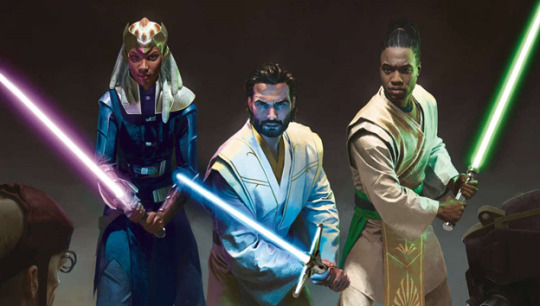
There are SO many reasons why the High Republic is worth your time to explore. I will try to outline some of them here below the cut (without any significant spoilers).
IT IS A LOVE LETTER TO THE JEDI

This is the era for everyone who loves the Jedi and wants to understand how they got to the point they did in the prequel era. It shows Jedi at their best: saving people, working together, being completely in tune with the Force (in so many beautiful and original ways), demonstrating creativity and flexibility and being rewarded for it, actually thinking through the ethics of things like the mind trick, and DEALING with their emotions rather than repressing them. It shows us how the rigid Jedi culture was saw in the prequels was a corruption of something that was originally healthy and uplifting. Jedi in this era are allowed to be flawed, and to grow, and have a community that supports them in doing so. This is the Jedi culture so many of us created as fix it fic for the prequel era, but made canon.
IT IS AN ERA OF HOPE
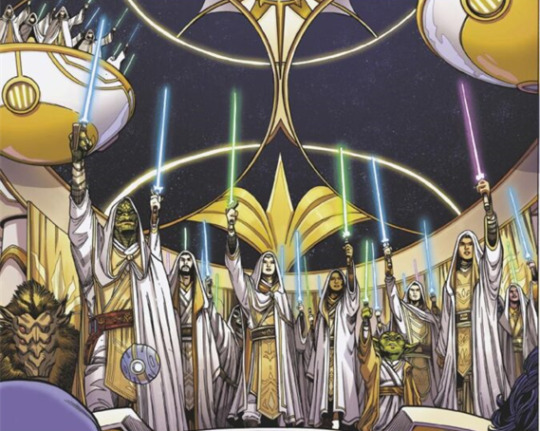
There are some serious problems in the High Republic Era. Without spoilers, the era opens with a terrible humanitarian crisis, laid over the Republic equivalent of the New Deal from US history. We see a lot of examples of people doing their best to be good to each other, and working for a more just and kind galaxy. They acknowledge that things are not perfect, but people from many different backgrounds (Jedi, politicians, farmers, pilots, business people) work together to try and make things better. I don’t know about you all, but with the darkness we see in the world today, I NEED some of that optimism in my escapist media. The High Republic provides that.
IT WILL GIVE YOU FEELINGS

The existing material so far is structured to really let you emotionally invest in the characters and their struggles. Unlike with many eras of Star Wars canon, characterization is not sacrificed for the sake of plot (though never fear, there is PLENTY of plot). That means there is huge scope for empathy. I’m not going to lie; I cried within the first three chapters of Light of the Jedi, as did several other people I know. It is POIGNANT in a way that feels truly genuine.
IT IS FUN
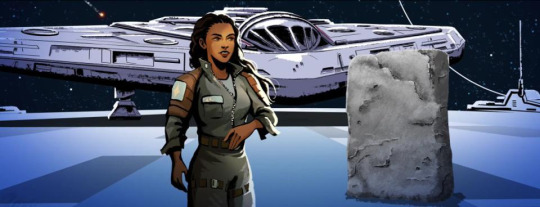
The writing team understands that, in the end, Star Wars is space fantasy. If your space fantasy is nothing but serious, gritty grimdark, it becomes pretentious and unbearable. So, for all that there is some heavy content in the High Republic (VERY heavy content – the Nihil should really have their own content warning), it has many moments of levity that keep it from taking itself too seriously. For example, the High Republic made Jedi bodice rippers canon. Also, characters like Geode exist (yes, that rock there is a CHARACTER). The result is something which honors the spirit of Star Wars, and keeps you engaged without being tedious or ridiculously depressing.
THE WRITING TEAM HAS DIVERSE PERSPECTIVES
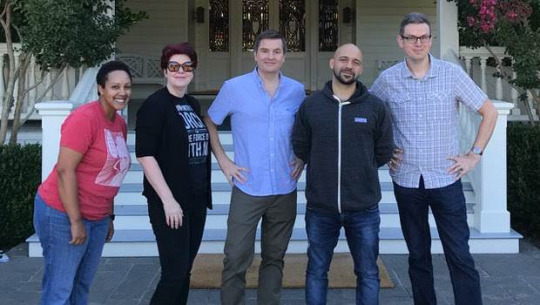
The main writing team consists of five people: Justina Ireland, Claudia Gray, Charles Soule, Daniel José Older, and Cavan Scott. You will note that includes two people of color, two women, and one out Queer person (in fact, one of the writers is all three of those things). This is a far cry from the white-cis-straight-man-dominated writing teams we have seen in the past. And when they bring in other people to the project, they make a point of looking for perspectives that aren’t represented on their team – for example, the manga is being co-written between Justina Ireland and Japanese writer Shima Shinya, and Ireland has stated in interviews that Shinya is taking the lead on the writing.
IT VALUES MEANINGFUL REPRESENTATION
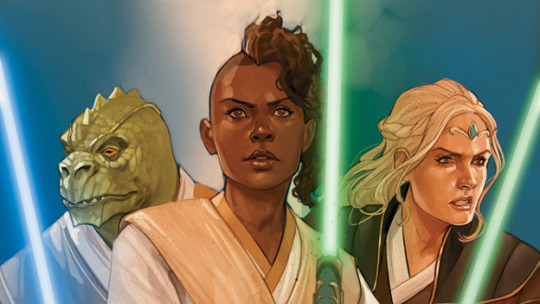
That diverse writing team means a cast that looks WAY more like the real world than any other era of Star Wars we’ve seen, in terms of representation. There are multiple characters of color, who are both heroes and central to the story. There are at least five canonical queer characters to date (a MLM couple, an Ace character, and two NB character). [EDIT: Thank you @legok9 for letting me know about the NB characters]. Among binary gendered characters, there is a very even balance of men and women. The writing team has also stated that they will be incorporating more representation of disability in the works to come. And the story is so much better for it – representation is included here BECAUSE it makes for more creative, believable, and original storytelling.
IT IS ACCESSIBLE
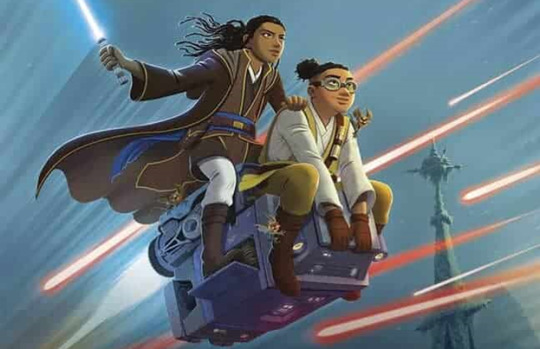
Because of the multiple formats, and the fact that it doesn’t rely on you knowing any prior lore, the High Republic offers many avenues to engage for people with all kinds of needs. Know nothing about Star Wars canon and feel intimidated about catching up? The canon is all new in this era anyway, so you’re fine. Can’t handle flashing lights? No problem – the little bit of video content that exists is totally free from the strobing effects that caused seizure and sensory issues. Need purely audio content? You can still have a full experience of the High Republic with the gorgeously sound-scaped audiobooks. Don’t have the attention span for books or long movies? Then the comics are your friend.
THERE IS SOMETHING FOR ALL
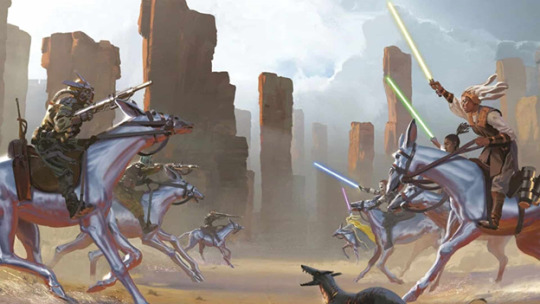
Between the books aimed towards adults and teens (and their respective audiobooks), the kids books, the comics, the manga, the short stories, AND the eventual TV show on Disney+, there is going to be content in the High Republic that suits most audiences. And that is just what has been announced so far – there is still more to come for phases II and III. This isn’t Star Wars written towards one group or demographic – it is Star Wars for everyone.
DID I MENTION THE FANCY JEDI UNIFORMS?
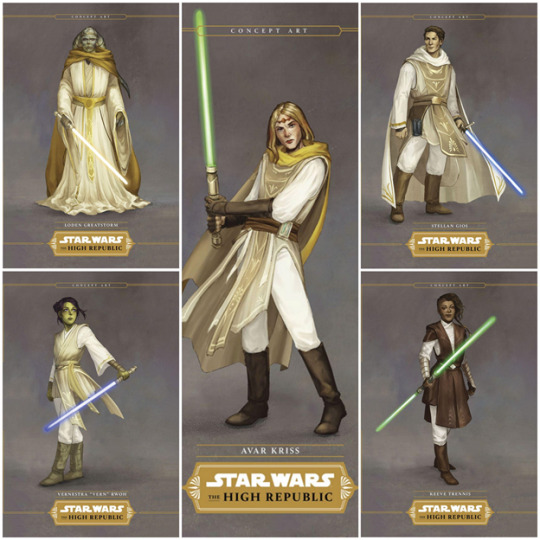
Because cosplayers and fanartists? This is the era for you. We are getting Jedi in silks with elaborate gold embroidery. Jedi with jewelry other decorative elements. Even the practical field uniforms have tooled and embossed leather. If you want to draw or make Jedi that have some of that that sweet LoTR-esque high fantasy aesthetic, the High Republic has your back. (Not going to lie – I am ALREADY imagining the time travel AUs. Put Obi-Wan in fancy clothes!)
OKAY, YOU’VE SOLD ME. WHERE SHOULD I START?
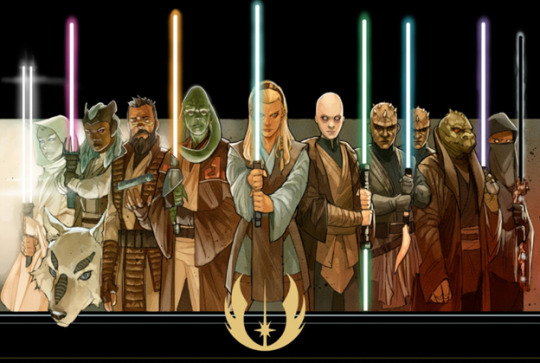
I strongly recommend everyone looking to get into the High Republic (who is old enough to be on Tumblr) start with Light of the Jedi by Charles Soule. I alternated between the physical book and the audio book, and found it delightful in both formats. After that, you have a lot of options. You can read or listen to the audio book of the YA novel A Test of Courage by Justina Ireland. You can check out the currently running Star Wars: The High Republic comic from Marvel, or the Star Wars: The High Republic Adventures comic from IDW. Or you can skip straight to Into the Dark by Claudia Gray. Honestly, there is no wrong order to try out most of the High Republic.
IN CONLUSION
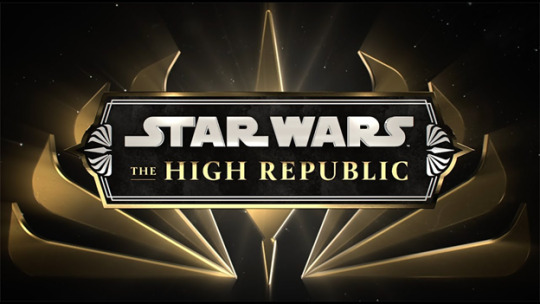
The High Republic is Star Wars written for people who DON’T want Star Wars to be a good ‘ol boys club for salty white dudes who don’t want to see anything but more of Luke Skywalker. It offers broad representation, and optimistic narrative, and whole bunch of awesome Jedi content. If you are someone who fell in love with Jedi in the prequel era, the High Republic will give you more of what you loved. And if you are totally new to Star Wars? The High Republic is here for you too.
So, go check it. And then go write fic for it (please, there are only, like, 14 fics on AO3, I am dying).
#star wars#the high republic#jedi#long post#recs#book recs#representation#seriously I cannot recommend this highly enough#everything about the high republic is so very tailored to what I love about star wars in general and Jedi specifically#also...sorry I had been absent here#I swear I still love you all#I just have limited interaction spoons these days and spend most of them on costuming stuff
145 notes
·
View notes
Text
Status of High Republic kids post-Phase I
(including main and side characters that are children, teens, or equivalent in thr books and comics. spoilers for everything published, including Tales of Light and Life and Starlight Coda, with additional spoilers for upcoming media under the cut)
(SB - Starlight Beacon, SBF - Starlight Beacon's Fall)
I. main Jedi kiddos (plus Zeen, a member of the Padawan squad)
Bell Zettifar – present on SB. survived. spent months on Eiram afterwards helping the relief efforts and searching for Burryaga. learned to fish.

Burryaga Agaburry – present during SBF, presumed dead in its aftermath. actually survived and was stranded in inaccessible part of Eiram’s ocean. eventually found and recovered by Bell. malnourished and with patchy fur.
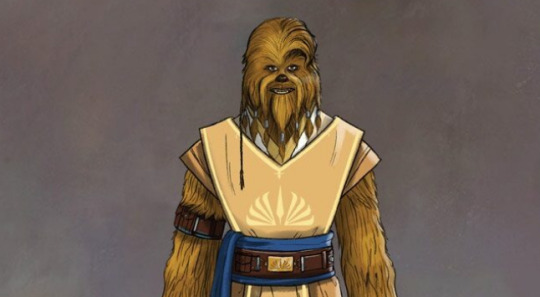
Farzala Tarabal – helped evacuate younglings off SB. last seen unconscious after confrontation with Nameless, still on SB. presumed dead in the immediate aftermath of SBF. status unknown.
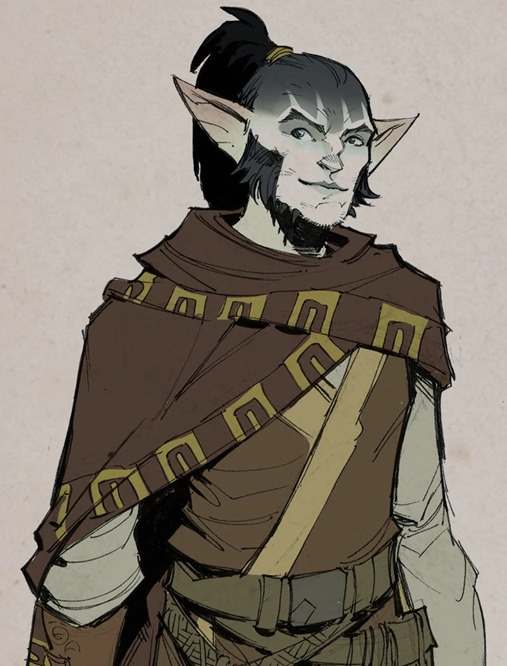
Lula Talisola – helped evacuate younglings off SB, then went after escaped prisoner Krix. last seen still on SB as it is on fire in Eiram’s atmosphere, thinking of Zeen. presumed dead in the immediate aftermath of SBF. status unknown.

Qort – present on SB. successfully evacuated with group of rescued younglings. sole confirmed survivor of the original Starhopper Padawan squad.

Ram Jomaram – on Corellia during SBF. survived battle with Nihil. all in all one of the least traumatized teens in the series despite his home being destroyed by Nihil.

Reath Silas – on Corellia during SBF. survived battle, got knighted and lost his replacement master right after. otherwise fine though.
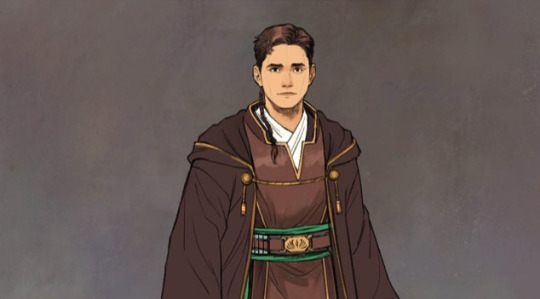
Vernestra Rwoh – on Eiram during SBF. lost Stellan and, as far as we know, Imri and Avon. traumatized beyond belief. months post-SBF following the Force as a Wayseeker without official approval. now headed to Ibbe to recover.

Zeen Mrala – on Corellia during SBF. survived battle with Nihil. last seen thinking of Lula, determined to find her in the aftermath.
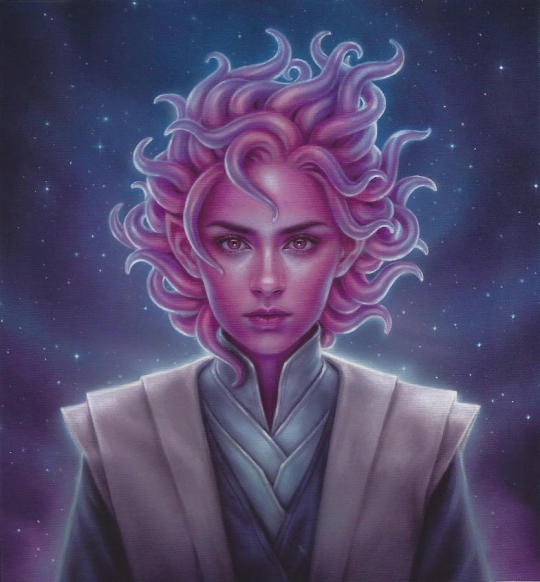
II. non-Jedi heroes
Affie Hollow - present during SBF, evacuated. helped with disaster relief on Eiram for a month afterwards. started work on rebuilding the Guild. has been seventeen for several years now.

Avon Starros - apparently presumed dead by Vernestra months after SBF. had very correct suspicions about her mom's Nihil connections the last time we saw her. status unknown.
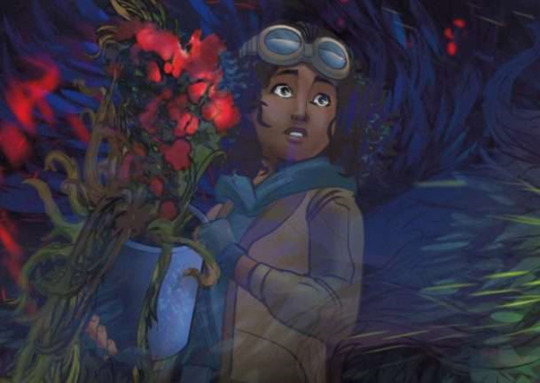
Crash and Svi’no – maybe I’d know if Lucasfilm weren’t releasing stories exclusively in print in one region only. survived battle on Corellia and got together so yay?
Honesty Weft - ehh he's probably fine? no real reason to believe otherwise. including him for completeness tbh
Jordanna Sparkburn and Sylvestri Yarrow – probably fine since we have no reason to think they were anywhere near SB or Corellia. might have to deal with Sylvestri's mother’s horrible death by Elzar during SBF. also got together so yay. also also if we can't have art of them together why don't the backgrounds of their concept art at least match up cleanly

III. minor Jedi characters
Amadeo Azzazzo – somehow matrix dodged all the death flags. don’t know if we’ll see him again but I’m proud of him and wish there was art of him.
Bibs and Rardal – present on SB. last seen squaring off against the Nameless. strongly implied to be dead.

Gabino and Kaimo – they better be okay!! a group of younglings were successfully evacuated off SB, though we didn’t see these 2 specifically.
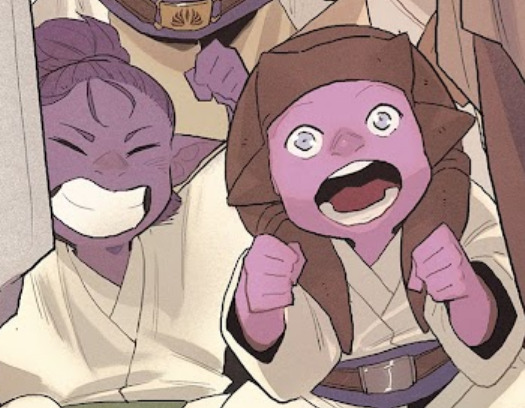
Imri Cantaros – apparently was present on SB. presumed dead by Vernestra months later. status unknown.

Nima and Viv’nia – present on SB for a bit but got sent away a while before SBF. presumably fine on Coruscant.

Ruu – the summary I found says he’s okay on Corellia. he also seems extremely cool and I hope I get to meet him. wish there was art.
Zint – present on SB. successfully evacuated with Qort.

IV. Nihil kids
Krix Kamerat – last seen still on SB as it is on fire in Eiram’s atmosphere, fighting Lula. status unknown.

Nan – present on SB. tried and failed to prevent its fall. evacuated in Koley Linn’s ship, returning to the Nihil.
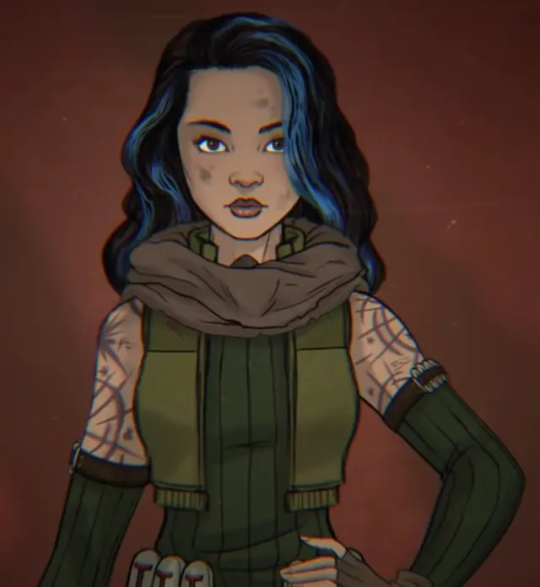
Sabata Krill – last seen on the bridge of a crashing ship over Corellia. status unknown.
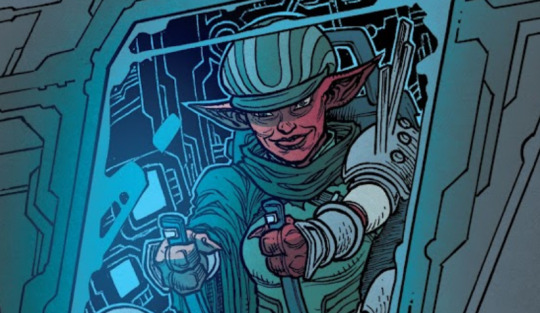
what we know from announcements of upcoming media:

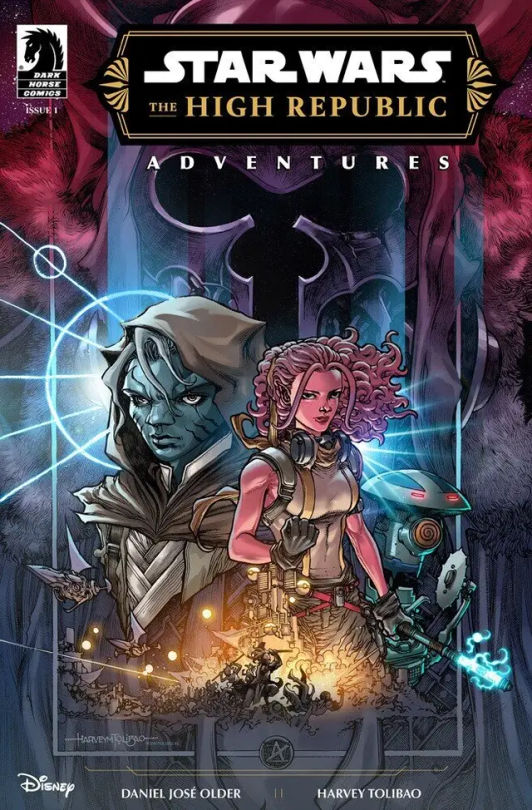
Avon – confirmed for Defy the Storm so alive (which we knew anyway due to her connection to Sana’s storyline during the OT).
Imri, Jordanna – confirmed for Defy the Storm so alive. I would guess the same goes for Sylvestri but I haven’t seen any info about that.
Lula – still MIA, presumed dead one whole year after SBF. the same probably goes for Farzala but he isn’t mentioned by name.
#the high republic#the high republic spoilers#tales of light and life#tales of light and life spoilers#the high republic adventures#midnight horizon#the fallen star#bell zettifar#burryaga agaburry#lula talisola#zeen mrala#avon starros#vernestra rwoh#affie hollow#qort
36 notes
·
View notes
Text
The Battle of Jedha Review
10/10. This was such a blast to listen to. I already usually listen to the High Republic in audiobook form, so the audio drama this time was quite the treat! The cast did great, and the production quality was high as always.
There is so much to unpack here, I can't stop thinking about it. The Jedi were as awesome as ever; each had the prowess (and power of perspective) to bring to the events that transpired. Despite being outmatched at times, I think they are still at their very best faced with immense odds.
I really recommend reading Quest for the Hidden City prior to Battle of Jedha, for its own sake or at least just to experience Silandra Sho. She's one of my favorite Jedi... ever? She's courageous, cunning, personable, strapped with a unique shield, humble, and an all-around badass. And you can have a drink with her. All I'm saying is that she would be a great friend to have for many reasons. The other characters were also fun! I think P3 being only programmed to speak in religious (Church of the Force, to be specific) phrases was a funny spin on the normal droid comic relief. The relationships between Aida Forte and Creighton, and then Silandra and Keth (+ P3) were heartwarming and real.
Jedha is always an interesting location to return to. The culture and politics of the Holy City are alive, and the audio drama really delivers on that front. Not everything is at it seems. Religious conflict is definitely present, and I imagine it’s not been the first major battle on the planet.
I would recommend this drama to anyone who loves The High Republic (and Star Wars). Phase II just keeps delivering time and again – I didn't think they could one-up Phase I but they are certainly trying, and I am here for every moment.
__________________________________________________
Spoiler stuff
Silandra's only flaw is that, because she is so good at saving people, she ends up saving the worst people in the galaxy too, including the main villains of both The Battle of Jedha and the entirety of Phase II. It’s actually hilarious.
The leveler is a lot more critical to the events of the drama than is apparent at first glance. I'll probably talk about it more later, but there are implications that the Jedi can't as easily predict the threats present because their senses are dulled, probably due to the leveler! That might be the most dangerous aspect – the Jedi can't see normal threats coming, not to mention the nameless themselves.
I'm glad Aida and Creighton made it out okay, but... I have much fear for them. Heading to Dalna has been a death sentence so far. I know the Path is out of town but they could return with the leveler, and all I gotta say is that they better not. I already would like to have a few words with the Mother for disrespecting Silandra, not to mention her crimes against Kevmo in Path of Deceit. She has to answer for a lot.
#the battle of jedha#the battle of jedha spoilers#the high republic#the high republic spoilers#silandra sho#creighton sun#aida forte#jedi#reviews#star wars#my posts
10 notes
·
View notes